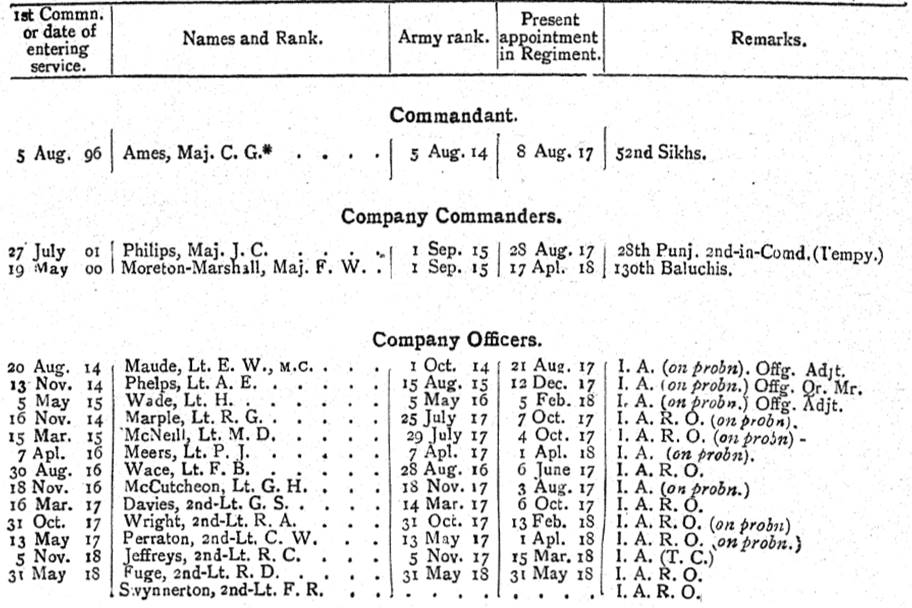This article on the short-lived 2nd Battalion 56th Punjabi Rifles (Frontier Force) aims to help you research the Battalion or a soldier who served with it during the First World War. I have written a separate article for the 1st Battalion 56th Punjabi Rifles (Frontier Force) and a series of guides to help you find out even more about researching someone who served in the Indian Army. The links below will take you to the guides:
The 2nd Battalion 56th Punjabi Rifles (Frontier Force) in the First World War
Lineage: The 2nd Battalion 56th Punjabi Rifles was formed at Multan (Punjab, Pakistan) on 5 June 1917, and became the 10th Battalion 13th Frontier Force Rifles, a Training Battalion, on the 1 March 1922. For a history of the Regiment’s lineage see my page on the 1st Battalion 56th Punjabi Rifles (Frontier Force).
Class Composition of Battalion in 1919: 1 Company of Dogras, 1 Company of Punjabi Muslims, 1 Company of Pathans and 1 Company of Sikhs. January 1922: 1 1/4 Companies of Punjabi Muslims, 1 1/4 Companies of Dogras, 1 1/4 Companies of Pathans and 1 1/4 Companies of Sikhs.
The 2nd Battalion 56th Punjabi Rifles was an Indian infantry battalion formed at Multan (Punjab, Pakistan) on 5 June 1917. The first commanding officer was Lieutenant-Colonel A. H. G. Thomas appointed from the 30th Punjabis, who commanded the Battalion briefly. Acting Lieutenant-Colonel Cecil Gardner Ames was appointed to the Battalion on 8 August 1917 from 52nd Sikhs and would command it through its genesis. Ames was a career Indian Army officer and had served in Somaliland and on the North West Frontier before the outbreak of war. During the First World War, he served in East Africa and was wounded in the shoulder at the Battle of Tanga on 4 November 1914 while attached to the 2nd Kashmir Rifles.

When I saw this battalion in October training was in a backward state. Malaria was prevalent, and the recruits from the Multan district had to be carefully dealt with just at first. No less than 86 were absent without leave of 600. There was a want of system about the training, and also a want of life and go. More instructors have since been trained, and an improvement may be expected now that the battalion has moved to a healthier station.
Confidential review reports on Indian Army units, depots, British officers, etc. for 1917-1918: IOR/L/MIL/7/17029
The Battalion improved in time for its next inspection for 1918-1919 where Lieutenant-Colonel D. Baird, reporting for Lieutenant-General Richard Wapshire, Commanding 4th (Quetta) Division wrote:
A very young Battalion in which good progress has been made. Another training season will result in much improvement of work in the field. Not fit for service.
Confidential review reports on Indian Army units, depots, British officers, etc. for 1918-1919: IOR/L/MIL/17030
In the January 1920 Indian Army List, the 2nd Battalion 56th Punjabi Rifles was stationed at Jullundur (Jalandhar, Punjab, India). By the April 1920 edition, the Battalion was overseas with its depot based at Jullundur. In the January 1922 edition, the Battalion was stationed at Ferozepore (Firozpur, Punjab) and the same year was redesignated as the 10th Battalion 13th Frontier Force Rifles, which was a Training Battalion.
War Diaries for the 2nd Battalion 56th Punjabi Rifles
Unfortunately, there are no war diaries for the 2nd Battalion 56th Punjabi Rifles.
Further Sources for the 2nd Battalion 56th Punjabi Rifles
For information regarding British and Indian officers who served with the 2nd Battalion 56th Punjabi Rifles, the Indian Army List should be consulted. Confidential reports for the Battalion are held at the British Library: Confidential Reports on Regiments etc. These reports also contain the annual reports of the British officers serving with the Battalion.
